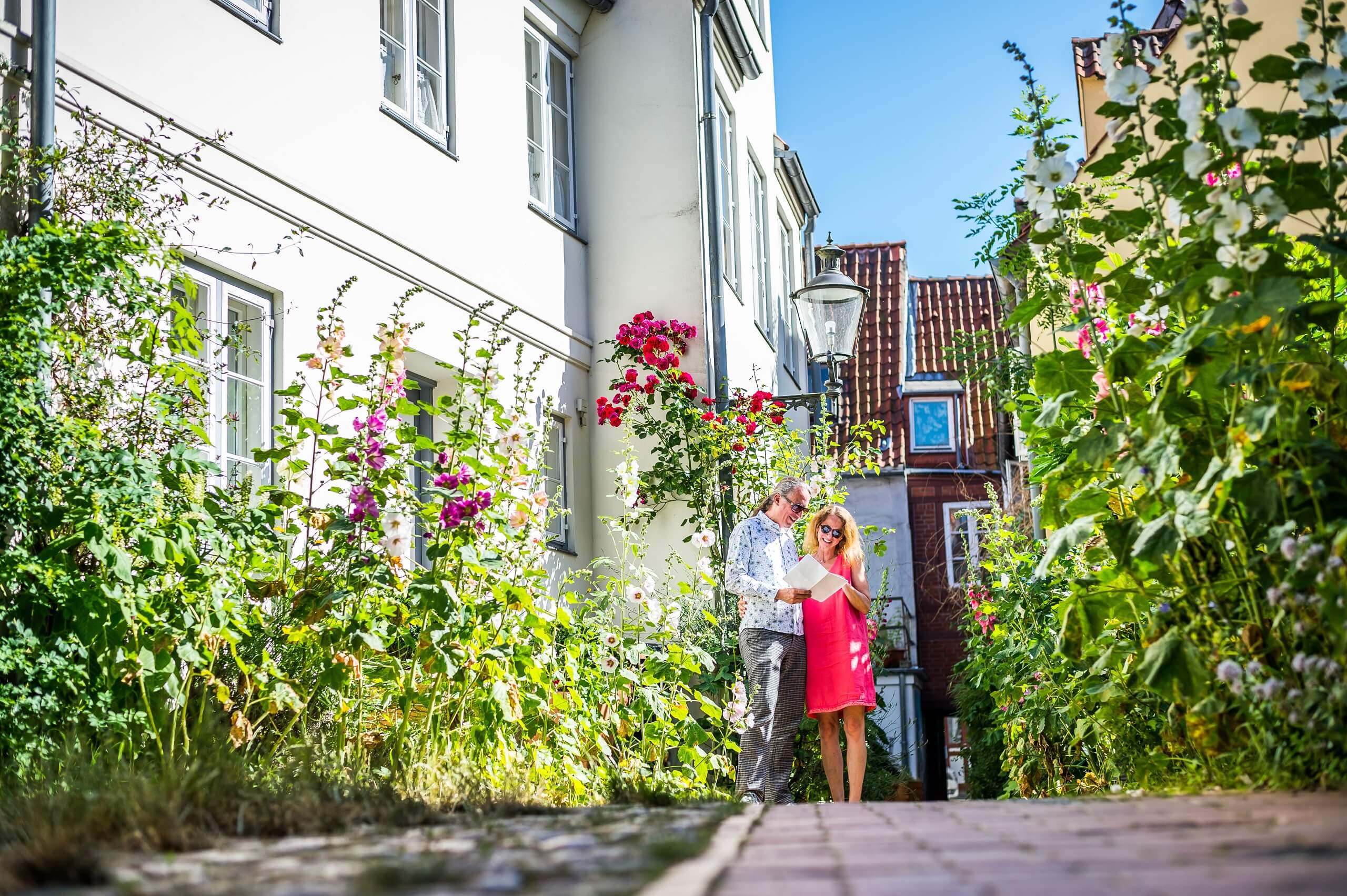HURRY TO SEE
THE ALLEYS

HURRY TO SEE
THE ALLEYS
The hidden world of alleys and courtyards
The hidden world of the historical residential alleys runs like a labyrinth through the rear courtyards of nearly the entire Old Town and today forms part of the Lübeck UNESCO World Heritage Site and the living urban culture. Once there used to be 180 inhabited alleys and courtyards, today there are around 80 left. Most of them are open to the public and freely accessible on a relaxed stroll through the Old Town, some are locked at night by a gate and a few immersed in their own private world behind closed doors. The small, lovingly restored alleyway houses today represent coveted living space in the heart of the town and second to none when it comes to idyllic romanticism. It was not always thus.
The first alleys and booths were built at the beginning of the 14th century due to a lack of space, as trade flourished in Lübeck and the population literally exploded. The living space within the city walls was no longer sufficient. So enterprising merchants and other clever homeowners came up with an idea: they built tiny one-storey and often windowless "stalls" in their backyards. The term "booth" derives from the Latin word "boda". A land registry distinction from a house (domus). They rented them out to servants, day labourers, craftsmen and simple seamen with their families. Almost 80% of the population lived in shacks.
The house is still standing out of pure habit
Did you know?
Don’t get lost and don’t miss anything! No-one has ever got lost but it’s best if one of our town guides leads you through the medieval labyrinth of Lübeck’s alleys and courtyards. You will hear the best stories and many funny anecdotes on a guided tour of the alleys and courtyards.
Then as now, Lübeck’s alleys and courtyards are public spaces but still lived in, and they are lovingly cared for, planted with trees and shrubs and decorated by the residents. Please therefore take care, show consideration on your visit and respect the privacy of the alley residents.
Füchtingshof
Lübeck’s largest and grandest sponsored courtyard and baroque jewel from 1640 is Füchtingshof in Glockengießerstraße. It was donated by Lübeck merchant and councillor Johann Füchting to look after the widows of merchants and sailors “for the benefit and best interests of the poor”. In the Courtyard Rules of 1792 it states that it is the widows’ duties are to “dress honourably and decently in keeping with their situation, to avoid any servile finery or brooches on their clothes and live quietly, modestly and honourably.”
Glockengießerstraße 23
Opening times: 9-12 a.m. | 3-6 p.m.
Dunkelgrüner Gang
The dark-green alley is part of the tangled system of alleys between Untertrave and Engelswisch with small shacks, gardens, dead-ends, a playground and hidden exits – a true labyrinth and green oasis which can be considered as an old, self-contained district. It was inhabited by “quirky” people, i.e. somewhat strange, idiosyncratic people, mostly associated with seafaring.
Haasenhof
This most recent of the sponsored courtyards in Lübeck acquired its name from the widow of the wine-dealer Johann Haase who founded the establishment between 1727 and 1729. In her will, she decreed that “13 flats were to be preserved in good structural condition at all times”. She determined that these flats were to be made available to 9 widows and the remaining 4 flats were to be occupied by 8 “virgins” – unmarried women.
Glandorps Hof
“Widows of honourable standing, good, honest behaviour” who are “oppressed by patiently endured poverty” were permitted to live in this sponsored courtyard from 1603. This courtyard in Glockengießerstraße was donated by Lübeck councillor and trader Johann Glandorp.
Kalandsgang
This alley is to be found level with Hartengrube 52 which even in the 15th century was known as “de wide Hagen” (the wide enclosure) due to its unusual width. The enclosure was expanded in 1489 after it became too indecent for the Town Council to rent shacks ex officio so-to-speak to “lewd women” who used to receive seamen in their flats on a professional basis. In 1557, a brotherhood (Kaland) consisting of ecclesiastical and lay members took over the alley. Since then, the name Kalandsgang (Brotherhood Alley) has stuck.
Hartengrube 52
Von-Höveln-Gang
This alleyway, located on Wahmstraße, was built from 1481 by the Lübeck councillor Tidemann Evinghusen as a passageway for the poor with free flats for 45 impecunious women. It was later named after its administrator von Höveln. Although the alley has an entrance door, it is open to the public.
Wahmstraße 73-77